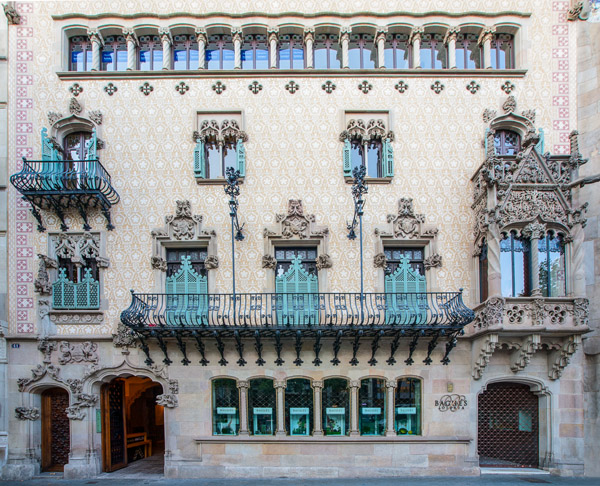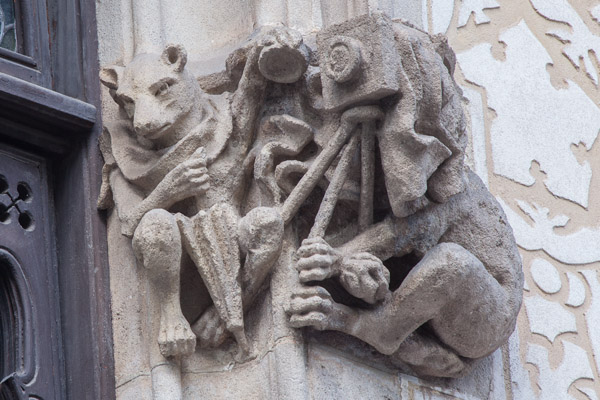The façade of Casa Amatller is shown to passers-by on Passeig de Gracia in Barcelona as a beautiful icon of modernist architecture in Catalonia. The architect Josep Puig i Cadafalch presented an enormously original front that combines architectural solutions that reinterpret styles from Romanesque to Gothic. Not to mention the fascinating pediment that crowns the façade, with its triangular and staggered shape, inspired by the buildings of northern Europe.
But let us pay attention to the details of the façade, to its unique decorative elements of sculptures and sgraffito. The artisans of modernism put themselves at the service of Puig i Cadafalch to materialize a symbolic program that highlights the family of the owner and promoter of the work, the industrial chocolate maker Antoni Amatller. The sculptors Eusebi Arnau and Alfons Juyol were in charge of making the decorative pieces that populate the façade.

On the sides of the access doors is a gypsy who carries a tame bear tied with a rope, while on the other side is a beautiful lady fighting a beast. Between the two doors of Casa Amatller is a gentleman who kills a dragon, saving the long-haired princess who watches the scene from the main floor. The latter is a representation of Sant Jordi, patron saint of Catalonia. Antoni Amatller vindicates this, since, together with the architect Josep Puig i Cadafalch, he was closely linked to the Catalan cultural and political recovery movements of the Reinaxença: Sant Jordi is a symbol of Catalonia’s reaffirmation.
In the other sculptural details of the access doors, above the arches, four characters can be observed that symbolize the arts: the painting, with a palette of colors in his hand; the sculpture, that holds a bust of a statue; the architecture, that observes a compass; and the music, making sound a harp. These four figures express Antoni Amatller’s promotion of the arts, both when it comes to relying on architects, artists and contemporary craftsmen for the construction of his house, and when it comes to creating an excellent art collection.
To discover the activities that defined Antoni Amatller we have to take the view to the balcony of the main floor. Each of the three openings has on its lintel a shield with symbols of industry, arts and collecting. In the capitals of each side of the doors there are sculptures with animals that carry out human activities, specifying the meaning of the allegories.
On the left balcony, the coat of arms contains a compass, a knife, a hammer and a king’s foot, accompanied by the figures of rabbits that melt iron and monkeys that he forges on the anvil. They refer to the industry that had allowed the fortune of the Amatller family.
The central balcony has a coat of arms with an open book and an old accordion camera, complemented by donkey writers with glasses and Cervantine lechuguilla around the neck and photographic dogs: they symbolise the arts. And they remember Antoni Amatller’s activity as an amateur photographer, elevating it to the rank of art. Did you know that his studio was behind the triangular pediment of the façade?

On the right balcony the coat of arms frames glass and ceramic objects. In the sculptures we see frogs blowing glass and piglets working on ceramics. It is an allusion to the collection undertaken by Antoni Amatller, who specialised in the glass of the Antiquity, a collection that was continued until today, being one of the best in its genre.
There are still more allusions to Antoni Amatller: in the window of his bedroom there is a man with a box camera, remembering the chocolate maker’s fondness for photography. On the other side of the window, a sculpture of an older woman watches over the princess mentioned in the episode of Sant Jordi. It could be some kind of celestine.
On the other hand, there is the allusion to the Amatller family. In the grandstand of Teresa Amatller’s bedroom there is a large capital A, accompanied by more undersized A’s. Together with the presence of the almond blossom (in Catalan “ametller”), and verses in which the flower of this tree is mentioned, it is a reference to the surname of the family, a successful generation of chocolatiers.
Finally, the flowers of the almond tree, with their characteristic five leaves, are regularly scattered throughout the façade: they are the sculptural finishing touches to the lines of window mouldings, but they are also present in the form of silkscreens on the colourful wall.
Casa Amatller has been shown since 1900 as a beautiful and fascinating building of Catalan modernism. However, thanks to reading the symbols on its façade, we know that it celebrates the success of Antoni Amatller’s family as an industrial chocolate maker and as a great promoter of the arts. The work of the Catalan bourgeois families who started modernism thanks to their patronage is reinforced.



